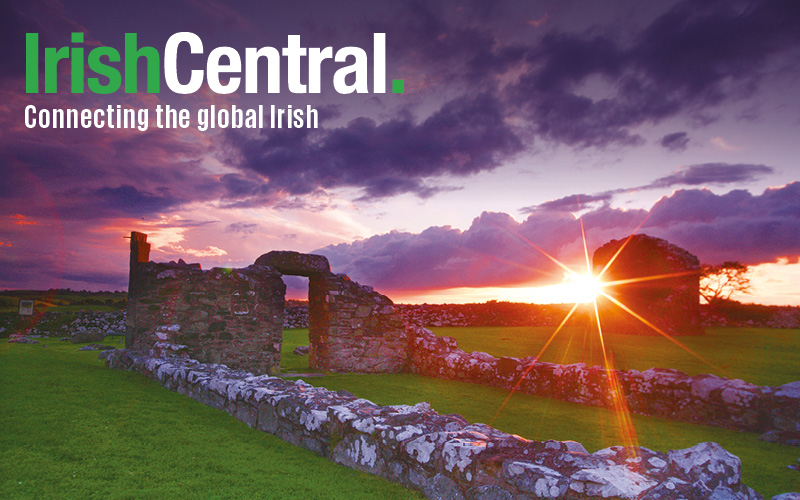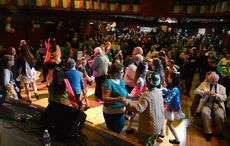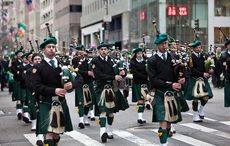Celebrating 250 Years of the New York City Saint Patrick’s Day Parade is the name of the groundbreaking illustrated history of one of the of the most famous and frequently contentious parades in the world. CAHIR O’DOHERTY talks to Parade Grand Marshall Mary Higgins Clark and the books press representative Turlough McConnell about the sure to be bestseller, that tells the whole parade story, good and bad.
It may come as a surprise to some, but controversy has been a frequent participant in just about every Saint Patrick’s Day parade ever marched in New York City.
From it’s earliest moments 250 years ago, the parade has often produced an element of the unexpected – thanks to varying degrees of crowd control and public order, or political statements, or even contested banners or contested participants.
In the remarkable new book Celebrating 250 Years of the New York City Saint Patrick’s Day Parade, celebrated New York historian John T. Ridge has assembled for the first time a comprehensive and often moving look at one of the most famous and frequently contentious parades in the world.
The celebration of Saint Patrick’s Day in New York City can be traced as far back as 1762, when a man named John Marshall hosted a dinner “at Mount Pleasant, near the college,” to mark the Irish patron saint’s day. Although there’s no record of a parade having taken place on the day, it is the first recorded example of a celebration in the city of the Irish patron saint’s feast day.
After that it kept on growing. In the 19 century it became quite common for the spectators to cause huge delays in the line of march by insisting on shaking the hands of their parading friends, or the politicians and bigwigs – even the grand marshal often had to contend with all the glad-handing.
Grousing parade officials have been a familiar element of the parades over three centuries, too: frequently complaining that routes were either too long or too short, or that the crowds were allowed to roam too freely, or that the participating groups were grandstanding shamelessly and holding up everyone else.
It’s surprising, in some respects, how little has changed. Trust the Irish, who have always excelled at discovering drama in even the most mundane arrangements. Quinnipiac University Press Representative Turlough McConnell, who was instrumental in the book’s genesis and promotion, told the Irish Voice it was a journey of discovery for all involved.
“The book came about because John Leahy, President of Quinnipiac University, has been involved in the parade for many years – since he was a young guy – and he always cared about the parade and has made it a big part of his life.”
In 1997 Leahy was appointed Grand Marshall of the parade and he decided to use his role as an educator in 1997 (the 150 anniversary of Black ’47, the darkest year of the Irish Famine) to educate people on the Great Hunger. He was also one of the people instrumental in getting the history of the Famine introduced to the High School curriculums in Connecticut.
“In the last few years Leahy felt the parade needed a real endowment to continue the work it has done,” McConnell says. “To date the parade has existed on a core voluntary group putting it together. Leahy decided that since the 250 anniversary of the New York City Saint Patrick’s Day parade is this year he would publish a book on the history of the parade as a milestone, through Quinnipiac University Press.”
Leahy appointed his Vice President of Public Affairs, Lynn Mosher Bushnell, as general editor of the book. “She thought she’d go out there and there’d be a whole archive of easily accessible historical materials to research. But there was nothing. There were just some photographs here and there. There was no archive, no central place.”
That proved they were doing groundbreaking work. Mosher Bushnell took on the project over two years, conducting research at every historical archive and every newspaper in New York. The most helpful place for source material turned out to be the Irish American archive at New York University (NYU) where she gathered previously unseen images for the book.
Meanwhile historian Ridge had written a chronology of the parade in 1989 that had impressed Leahy. Ridge was commissioned to write the text for the new book in association with the research material complied by Mosher Bushnell.
“The book has images that stretch all the way back to the late 1800’s,” says McConnell. “It’s a great historic document that we have about the parade that never existed before. Currently the exhibition that accompanies the book is on display at the Irish consulate and we’ve been invited to bring to the Irish Cultural Center in Phoenix, Arizona – where there is a significant former New York population.
ooksellers like Barnes and Noble, who are creating displays for it in their windows here in New York, have embraced the book. They suspect it will sell particularly well at Christmas. The biggest thing about the book is that all proceeds from it will go to an endowment for the parade in years to come.”
The launch of the book dovetails nicely with the fact that the Grand Marshall of the 2011 parade is an author, the 80 million books bestseller Mary Higgins Clark, who speaks, McConnell says, to the character of the parade. She has great character herself, having survived tragedies in her personal life, and she’s a terrific representative for the Irish.
“She’s a brilliant choice for the 250 anniversary,” says McConnell. “She is someone who will live in history, her books will live on, and she’s someone who’s just a modest, wonderful Irish American woman who cares about her heritage. She says that when she marches up Fifth Avenue she will bring the ghosts of all the Irish marched. She’s taking them all with her.”
McConnell admits that his own understanding of the parade has changed over time. “When I came here in the 1970’s from the North it was a bit of an affront to me. I didn’t understand why they could be so excited about being Irish when we were having such a terrible time at home politically. It took me many years to understand that Irish America is a different place. It took me a number of years to understand that Irish America played and would play a significant role in the story of Ireland itself.”
McConnell says he was surprised to learn the parade has almost always been controversial. “When you think this parade began 14 years before this country became a nation, 14 years before the signing of the Declaration of Independence, they were having a Saint Patrick’s Day celebration, it’s astounding. In a new biography of George Washington they mention how he walks up Fifth Avenue and bumps into a crowd of Irishmen marching in the parade. We’ve been here since before the country was a nation.”
The most longstanding (and for the younger generation, perhaps the most galling) controversy surrounding the parade is its continuing exclusion of Irish gay groups from being allowed to march under their own banners. The standoff, which was highly contentious and almost shut the parade down, resulted in a Supreme Court ruling and a stalemate that harms Irish America’s reputation every March 17, critics contend.
“The parade has always had controversy. In Ireland there’s an old saying that it’s the row that matters. It’s a real indicator of the parade’s Irishness that it can row.”
Mary Higgins Clark, the 2011 Grand Marshall and an ardent promoter of the new book told the Irish Voice that the greatest surprise of her professional career was being asked to Grand Marshall in the first place.
“I received a call from John Fitzsimons who asked me if I would come to dinner. He said you’re going to be invited to be the Grand Marshall of the parade. I almost dropped the phone. It no more occurred to me – ever – that I would be invited. It wasn’t one of my secret wishes, it wasn’t a case of if a dream came true – it literally never occurred to me that I would be invited to do it.”
Higgins Clark has happy memories of the parade down the years and so the decision to say yes came quickly. “My own memories of the parade involve the wonderful bands and the bagpipes and all those schools marching. And the spirit of it – rain or shine, hot or cold, the spirit of the thing was so joyous.”
McConnell adds that her selection was a savvy one because of what she represents to her 80 million readers: resourcefulness, smarts and grace under pressure. Modest as ever, Higgins Clarks demurs the accolades. Courage in the face of adversity is an Irish tradition, she says.
“The old Irish said goodbye to their children and didn’t see them again. So many of them buried children. My husband’s grandmother had 13 children. Four lived. It was said once that it was safer to be a soldier in the trenches than a baby in New York because the care wasn’t as good.”
The Irish has a sense of humor that never fails them no matter what she adds, and that sustains her. “My brother-in-law was only buried a week ago and we were great pals. He was my younger brothers best friend since they were five – so he was brother not brother-in-law. On the day he died his wife give him a little malt whiskey and asked him how did that taste Ken? He replied “like shit.” His final words. Don’t you love it? Right to the every end the wit and the humor is terrific.”
Regardless of the continuing controversies and the day when they’re inevitably put to rest, there is one thing that unites all the Irish says McConnell. “What are parades all about, why are we sharing and dressing up and doing all of this stuff? It’s about community. It’s the greatest expression of community there is, other than the ballot box. We put ourselves out there, the parade has always captured our strengths and our weaknesses.”
Celebrating 250 Years of the New York City Saint Patrick’s Day Parade, Quinnipiac University Press $49.95.




Comments